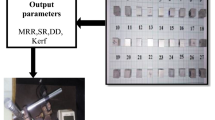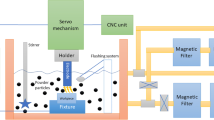Abstract
Electrical discharge machining (EDM) is a process for shaping hard metals and forming deep and complex shaped holes by arc erosion in all types of electro conductive materials. In the present work, the effectiveness of the EDM process with tungsten carbide and cobalt composites is evaluated in terms of the material removal rate and the surface finish quality of the workpiece produced. The objective of this research is to study the influence of operating parameters of EDM such as pulse current, pulse on time, electrode rotation and flushing pressure on material removal rate and surface roughness. The experimental results are used to develop the statistical models based on second order polynomial equations for the different process characteristics. The non-dominated sorting genetic algorithm (NSGA-II) has been used to optimize the processing conditions. A non-dominated solution set has been obtained and reported.
Similar content being viewed by others
References
Luis CJ, Puertas I, Villa G (2005) Material removal rate and electrode wear study on the EDM of silicon carbide. J Mater Process Technol 164(165):889–896
Lee SH, Li XP (2001) Study of the effect of machining parameters on the machining characteristics in electrical discharge machining of tungsten carbide. J Mater Process Technol 115:344–350
Chen Y, Mahdavian SM (1999) Parametric study into erosion wear in a computer numerical controlled electro-discharge machining process. J Wear 236:350–354
Kuriakose S, Shunmugam MS (2005) Multi objective optimization of wire electro discharge machining process by non dominated sorting genetic algorithm. J Mater Process Technol 170:133–141
Deb K, Pratap A, Agarwal S, Meyarivan T (2002) A fast elitist multi-objective genetic algorithm: NSGA-II. IEEE T Evolut Comput 6(2):182–197
Raghuwanshi MM, Kakde OG (2004) Survey on multiobjective evolutionary and real coded genetic algorithms. In: Proceedings of the 8th Asia Pacific symposium on intelligent and evolutionary systems, Cairns, Australia, pp 150–161
Srinivas N, Deb K (1994) Multiobjective optimization using nondominated sorting in genetic algorithms. Evol Comput 2(3):221–248
Deb K, Sundar J, Rao N UB, Chaudhuri S (2006) Reference point based multi objective optimization using evolutionary algorithms. Int J Comp Intell Res 2(3):273–286
lgnizio JP (1976) Goal programming and its extensions. Lexington Books, Lexington, MA, USA
Kanagarajan D, Karthikeyan R, Palanikumar K, Paulo Davim J (2007) Application of goal programming technique for electro discharge machining characteristics of cemented carbide (WC/Co). Int J Mater Product Technol (submitted)
Fu B (2005) Piezo electric actuator design via multiobjective optimization methods. PhD thesis, University of Paderborn, Germany, pp 39–41
Nassif N, Kajl S, Sabourin R (2005) Optimization of HVAC control system strategy using two objective genetic algorithms. J HVAC&R Res 11(3):459-486
Seshadri A (2006) NSGA - II: A multi-objective optimization algorithm. Mathlab central, file exchange, Mathworks. http://www.mathworks.com/matlabcentral/fileexchange. Accessed 09 January 2007
Deb K (1998) Non linear goal programming using multi objective genetic algorithms. Technical report CI-60/98, Department of Computer Science/LS11, University of Dortmund, Germany
Deb K, Agarwal RP (1995) Simulated binary crossover for continuous search space. Complex Systems 9:115–148
Beyer H-G, Deb K (2001) On self-adaptive features in real-parameter evolutionary algorithm. IEEE T Evolut Comput 5(3):250–270
Montgomery DC, Peck EA, Vining GG (2003) Introduction to linear regression analysis, 3rd edn. Wiley, New York
Joins JA, Gupta D (2002) Supply chain multi objective simulation optimization. In: Proceedings of the 2002 winter simulation conference, Raleigh, NC, USA
Trueman CS, Huddleston J (2000) Material removal by spalling during EDM of ceramics. J Eur Ceram Soc 20:1629–1635
Zhang JH, Lee TC, Lau WS (1997) Study on the electrodischarge machining of a hot pressed aluminum oxide based ceramic. J Mater Process Technol 63:908–912
Ghoreishi J, Atkinson A (2002) Comparative experimental study of machining characteristics in vibratory, rotary & vibro rotary electro discharge machining. J Mater Process Technol 120:374–384
Mohan B, Rajadurai A, Satyanarayana KG (2002) Effect of SiC and rotation of electrode on electric discharge machining of Al-SiC composite. J Mater Process Technol 5845:1–8
Author information
Authors and Affiliations
Corresponding author
Rights and permissions
About this article
Cite this article
Kanagarajan, D., Karthikeyan, R., Palanikumar, K. et al. Optimization of electrical discharge machining characteristics of WC/Co composites using non-dominated sorting genetic algorithm (NSGA-II). Int J Adv Manuf Technol 36, 1124–1132 (2008). https://doi.org/10.1007/s00170-006-0921-8
Received:
Accepted:
Published:
Issue Date:
DOI: https://doi.org/10.1007/s00170-006-0921-8




